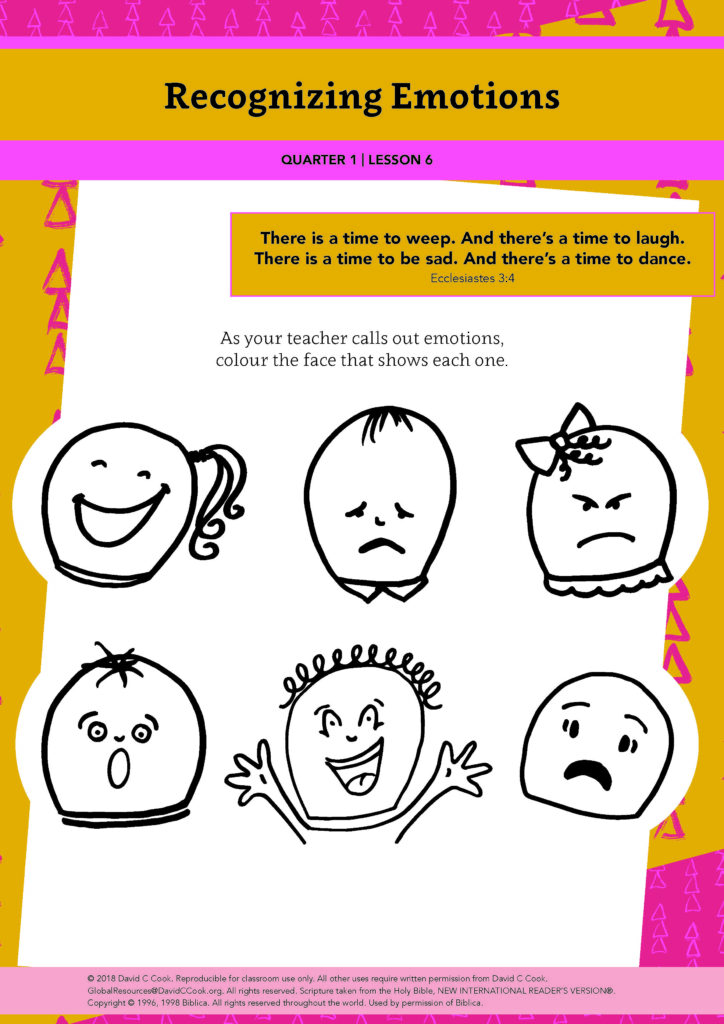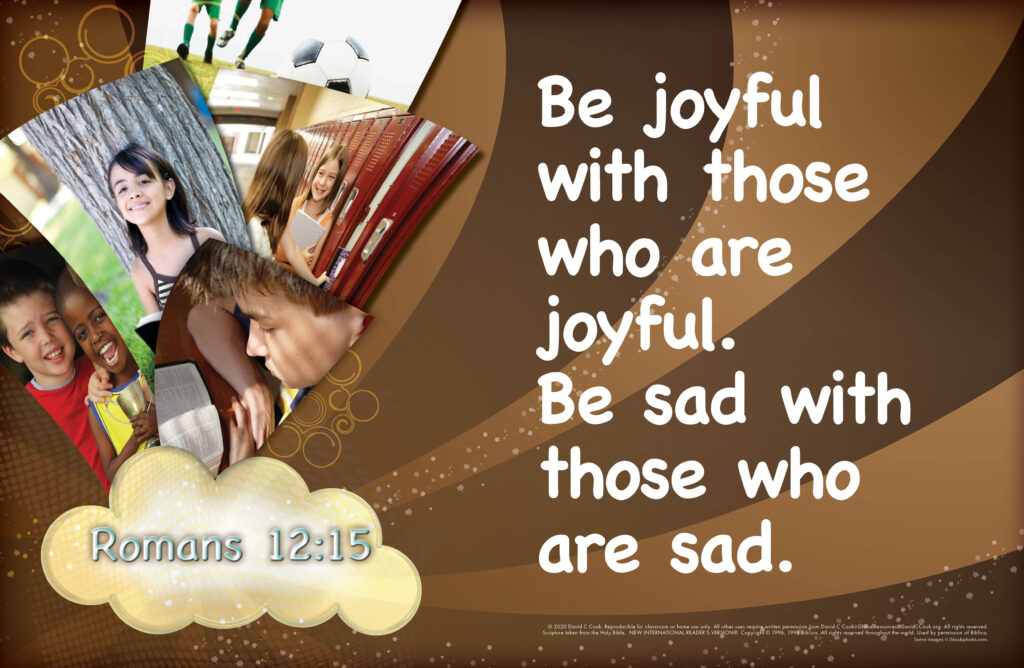During the lesson, the information for you to know is written in regular type, and what we suggest speaking or reading aloud to children is in bold. All resources for this lesson, including the Teacher Guide, Student Page, Family Connection Card, and other resources can be downloaded in a ZIP file by clicking on the following link:
In some lessons you will find "resource articles." These are articles written by experts from around the world to help equip you for your work with children and adolescents. Share them with parents or guardians if you consider it appropriate.
Print out the emotion signs from the end of the lesson before class.
Each heart knows its own sadness. And no one else can share its joy.
Proverbs 14:10
Emotions are an important part of life. It is difficult to do anything without feeling an emotion. Joy is a strong emotion. Think of a time when your heart was filled with joy. When you feel joyous, it can feel like God is celebrating with you. Now think of a time when you felt sad. Why were you sad? How did you show your sadness? It can be difficult to manage sadness, especially when you feel you are alone. But, as a child of God, you are never alone.
Emotions can be complicated. You may not recognize what you are feeling in a particular moment. Think again of those joyful or sad moments. Did you fully recognize what you felt during that time or only afterward? Were you able to express what you were feeling? God encourages you to freely express to Him all that is in your heart. If you have struggled to deal with your strong emotions in healthy ways, ask God to show you what to do. He made you and knows what emotion you are feeling. He can help us deal with emotions in healthy ways.
Encourage families to play an emotions game with their children. Suggest that they show different emotions on their faces and have the children name each emotion. Explain that by helping children recognize emotions, they will be better prepared to respond appropriately to visual emotional clues.
Teacher Tip: If possible, email or text the Family Connection Card to the families of your students.
Smile and greet the children as they come into class. Try to greet the children by name if you can remember them.
Last time we met, you learned that emotions are signals that help us know when something is happening inside of us. Today, you will learn how to recognize some of the emotions you feel.
We will play a game to help us show our emotions. When I say an emotion, I want you to show me how your face would look if you felt that way. Let’s try an example together. Show me how you look when you are happy.
Smile with the children to demonstrate what you look like when you are happy.
Very good! Let’s try showing other emotions.
I like your expressions. When I say, “Now!” I want each of you to show me your favourite emotion. (Pause) 1, 2, 3, now!
Allow 2–3 children to respond.
When I say, “Now!” I want each of you to show me an emotion you do not like. (Pause) 1, 2, 3, now!
Allow 2–3 children to respond.
While we sometimes experience emotions that we do not like, they are still part of our lives, and it is important to recognize when we feel them. God gave us many emotions. He will help us deal with the difficult emotions we sometimes feel. We will not have time to talk about all of our emotions in this lesson, but we will learn about some of the emotions we often feel.
Optional: If you are using the Student Pages, play an emotions colouring game. Have students colour the faces as you name each emotion. Say, “Happy,” then allow them to colour the happy faces. Do this for the following emotions: happy, sad, angry, surprised, excited, and scared.

God created emotions. He gives us opportunities to feel each of the emotions He created. In fact, the Bible tells us:
Read the verses in this lesson directly from your Bible.
There is a time to weep. And there’s a time to laugh. There is a time to be sad. And there’s a time to dance.
Ecclesiastes 3:4
Let’s make teams to answer questions about our emotions. I will give you a number. To help you remember your number, hold up that number of fingers on your hands.
Assign each student a number, starting with 1 and ending with 10. When you reach 10, start over with 1. Make sure every child has a number. If you have a group of children that is smaller than 20, count to 5 and start over.
Who is holding up 1 finger? Everyone with 1 finger up, come sit together here (point to a location in your teaching space).
Wait for the first group of students to get to their location. Then, repeat the instruction with each of the other numbers until all 10 groups are sitting in different areas.
Answer the following questions in your groups. Be sure that each person gets the chance to answer. Think of a time when you cried.
Pause for a few seconds to allow the children to think. Then ask the following questions.
Allow 2–3 minutes for the children to answer the questions in their groups.
When we cry, we are usually sad. Sadness is the emotion you feel when something makes you very unhappy. We will talk more about crying in a moment. Now, think of a time when you laughed.
Pause for a few seconds to allow the children to think. Then ask the following questions.
Allow 2–3 minutes for the children to answer the questions in their groups.
When we laugh, we are usually happy. Think of a time when you felt so happy you wanted to dance or jump up in the air.
This emotion is called joy. Joy is a feeling of great happiness mixed with excitement. Joy is hard to keep inside! When you are filled with God’s love, you experience joy. Joy can make us dance and laugh. Here is a verse from the Bible that speaks of joy:
Clap your hands, all you nations. Shout to God with cries of joy.
Psalm 47:1
When something very exciting happens, we can be filled with so much joy that it makes us cry. Other strong emotions can also make us cry. We may cry when we are angry, frightened, joyful, or sad.
Listen to this verse that shows us what God says about our emotions:
A happy heart makes a face look cheerful. But a sad heart produces a broken spirit.
Proverbs 15:13
Help children understand that what we feel shows on our faces. But sometimes we keep emotions inside, and that is not healthy.
Sometimes our emotions are easy to understand. We know when we feel happy or sad. Sometimes, though, we feel a small amount of happiness mixed with some sadness. This can be confusing. When we learn to name our emotions, it can help us understand what we feel and why we feel that way.
You just learned to identify some emotions. Let’s practice using them. We will play a game to help you recognize your emotions. I will choose 4 children to help me with the game.
Choose 4 children.
Now, I will give each of you an emotion. (Name) will be happy, so smile. (Name), you will frown because you are sad. (Name), show me a surprised look. (Name), jump or dance or clap because you are joyful.
Give the 4 children the emotion signs. Have them stand in different areas around your teaching space.

Those of you who are helping us with emotions, stay in your places as the rest of the children move around the room.
Remind the students which child represents each emotion before beginning the activity.
I will read some situations. Move to the child who shows the emotion you feel when you think about that situation.
Make sure the children who are assigned to the 4 emotions show the appropriate emotional expressions on their faces and hold up the emotion signs.
Optional: If you have time, think of your own situations and have the children respond to them. Do not add more than 3 additional situations to allow enough time for the rest of the lesson.
Good job showing your emotions! You may all sit down.
It is important to be able to recognize your emotions. When you understand your emotions, you can find ways to show others what you are feeling. This week, take time to recognize the emotions you feel. Also, look at the faces of the people around you and try to figure out what emotions they feel. If you listen to any stories this week, pay attention to words that show you the emotions felt by the characters. This could include readings from the Bible.
If possible, show the Memory Verse poster. Then read the memory verse from your Bible to the class.
Be joyful with those who are joyful. Be sad with those who are sad.
Romans 12:15

Repeat the rhythm you created last week. Encourage students to clap or pat their hands on a surface to help keep the rhythm. They may also choose to dance as they say the words. Repeat the verse and rhythm with the children at least 3 times.
End class by speaking this blessing, based on Ecclesiastes 3:4, over the children.
Blessing: May you know that the Lord has given you a time to feel every emotion. May you know that He cares about all of your emotions because He loves you.
If you have time, share this song with your children to celebrate how great God is! Use this as your worship theme this quarter.
Life on Life ©2020 David C Cook. Reproducible for home or classroom use only. All other uses require written permission from David C Cook [email protected]. All rights reserved.